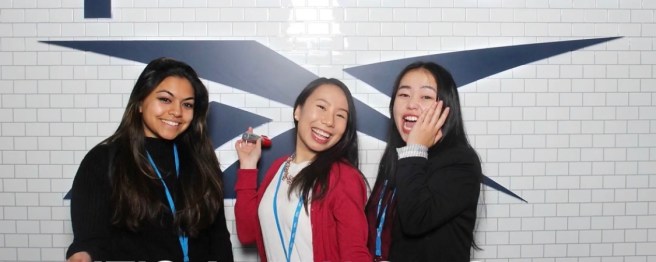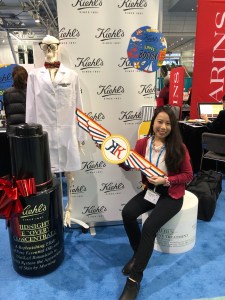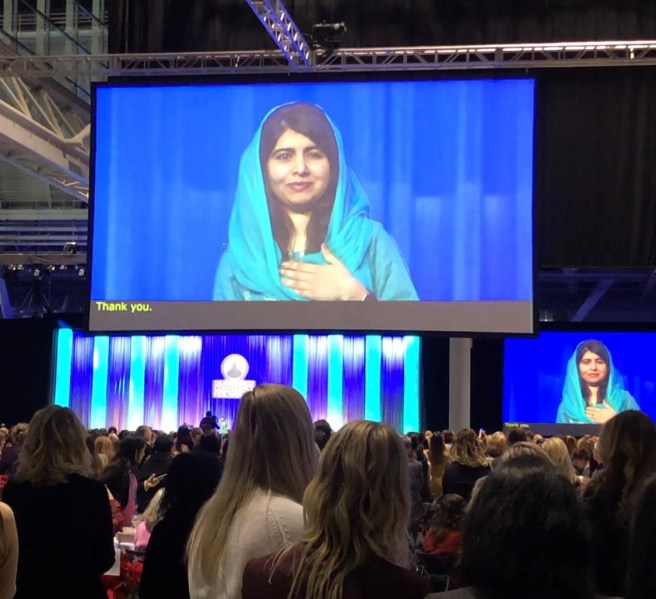Hey guys! There were roughly 12,000 attendees at the MA Conference for Women last week and I had the wonderful opportunity to be one of these attendees on behalf of my company! (I am an associate software engineer for those who may not know.)

I took the train into Boston and was at the convention center all day long with booths to see, sessions to attend, and people to meet. When we arrived, we received attendee “swag bags” filled with snacks, a water bottle, the event guidebook notebook, and other miscellaneous items.
Tips on how to make the most of the event:

luckily I was warned of these, i’m now queen of the event
- Arrive early: by 7am to head into the line or else you’ll have to spend time outside in the cold waiting to get through security and this way you’ll be one of the first to grab breakfast (free) and hit the booths down in the exhibition hall
- Skip the coat check–bring a warm enough but lighter jacket to carry or else you’ll have to be in line twice and there’s sooooo many coats in the coat check
- Use the womens restroom: I know, like isn’t that obvious? They actually convert a bunch of the mens restrooms into womens restrooms for the event, but the permanent womens restrooms have a lot more stalls. I accidentally waited in line for one of the converted restrooms for a long time only to find there were only 3 usable stalls and the other half was urinals!
Overview of Events and Sessions I Attended:
full schedule here
Opening Keynote Session
 Featuring Simon Sinek, Amanda Southworth, Yara Shahidi, and others; we were welcomed to a day of reminders that we can kick ass!!!
Featuring Simon Sinek, Amanda Southworth, Yara Shahidi, and others; we were welcomed to a day of reminders that we can kick ass!!!
- Sinek focused on the infinite game: explaining how learning from our competitor and using what we can study from them could help us become better ourselves and get stronger (and vice versa).
- Southworth told her story of mental health and how coding not only helped herself but enabled her to help others too.
- Shahidi is asked a question and answers with how she was taught at an early age about financial independence and how to be smart about money; saving it, spending it, and donating it.
Exhibition Hall (ft. sponsor booths, small business marketplace, and roundtable discussions)


- So. Many. Things. Being. Given. Away.
- And so many photo opportunities!
- Essentially, I came home with (on top of the swag bag stuff) a T Shirt, schrunchie, button pin, mirror, mints and lip balm, crystal nail file, travel brush and sewing kit in one, pens, magazine, candy, and more!
Unplugged: Reclaiming Balance in a Connected World (POE)

-
- This was an interesting panel session on unplugging from the social media world, turning 24/7 into 24/6.
- Tiffany Schlain (filmmaker, founder of The Webby Awards, author) talks about a “tech sabbath” of sorts that her family has done for almost 10 years now where they unplug from their devices for one 24-hour period a week and focus on the present.
- Mary Laura Philpott (author of I Miss You When I Blink) catches attention from the Type-As of the room, those who love lists and getting things done once they’re started. It’s her journey of accepting that our time is our time and it’s okay to take it back to do what we want.
- Stephanie Humphrey (technology and lifestyle content creator) discusses how she tries to unplug even with a career that consists of being on social media. Setting time for planning in one period and then scheduling posts is a must.
The Likability Trap: Women, Leadership and the Double-Bind
 Alicia Menendez, asked us a question: do you want to be likable or do you want to be successful? Her answer is to ALWAYS. CHOOSE. SUCCESS. People will always either like you or not like you for various reasons and it should not hold you back from reaching your goals.
Alicia Menendez, asked us a question: do you want to be likable or do you want to be successful? Her answer is to ALWAYS. CHOOSE. SUCCESS. People will always either like you or not like you for various reasons and it should not hold you back from reaching your goals.
- Yvonne Garcia, Minda Harts, and Erica Keswin joined Menendez in discussing their own experiences of having to choose between being liked or being successful in their workplace and the feedback they have sometimes received from it.
Keynote Luncheon: Malala Yousafzai, Tara Westover, Megan Rapinoe

All of the women involved in the keynotes, panel sessions, and other discussions have all done something to be recognized as leaders, mentors, or just those to look up to. During the keynote luncheon, we also were lucky to hear from Malala Yousafzai, Tara Westover, Megan Rapinoe, and others.
- Yousafzai spoke of her journey that most of us have heard about (if you need a refresher) and how her father continued to push for her education when extremists who took over their town banned girls from school and how it has developed her into the strong woman she is today. She continues to fight for 12 years of education for girls in countries who are less able to receive the opportunity.
- Westover joked about how her job is to be a professional narcissist, telling her story about how she was raised in a family that did not believe that the government, education, and other things were genuinely real (instead seen as a conspiracy). She eventually went on to being enrolled and educated at the age of 17 and then went on to get her PhD.
- Rapinoe was her authentic self with Kara Swisher; it was highly entertaining to listen to them discuss important topics like how Rapinoe was fighting for equal pay among professional soccer players (ex. how the womens soccer team is not compensated the same as the mens soccer team), the upcoming election, and various other topics.
While leaving the convention center, I realized that I was feeling so empowered, a feeling that I had not felt in a while. It makes me want to continue to chase after it all.
I’m hoping to get the chance to continue attending The MA Conference for Women and other events like this! The 2020 Grace Hopper Celebration for Women Technologists is also on my radar and I can’t wait to launch into this potential opportunity!


 Hey guys, it’s a weird feeling to be wrapping up my last semester in my undergraduate career in computer science (and sociology). For this final installment of my AMPATH sprint series, I will just go over the general overview of what went on for my team.
Hey guys, it’s a weird feeling to be wrapping up my last semester in my undergraduate career in computer science (and sociology). For this final installment of my AMPATH sprint series, I will just go over the general overview of what went on for my team.
 In this final installment of my individual apprenticeship patterns, I think an important one to write about would be Find Mentors. To summarize the main point of this one, I would say that it encourages people to observe their role and their surroundings to see where they can find the most value from learning or use their resources. It encourages you to look at things from one level back instead of blindly jumping into something right away.
In this final installment of my individual apprenticeship patterns, I think an important one to write about would be Find Mentors. To summarize the main point of this one, I would say that it encourages people to observe their role and their surroundings to see where they can find the most value from learning or use their resources. It encourages you to look at things from one level back instead of blindly jumping into something right away.
 Over the past two weeks, my team continued to discuss what we are working on as usual. We have come to the conclusion that we will add our Search Bar component once there are updates and more of a base to work off of. This was concluded after we realized that the process would be much more efficient. The parameters and details on the search bar would be harder to figure out without making up a base anyways.
Over the past two weeks, my team continued to discuss what we are working on as usual. We have come to the conclusion that we will add our Search Bar component once there are updates and more of a base to work off of. This was concluded after we realized that the process would be much more efficient. The parameters and details on the search bar would be harder to figure out without making up a base anyways.
 For my second-to-last individual apprenticeship pattern, I have decided to go with something a little more relevant to my current situation–relating to starting my career post-graduation.
For my second-to-last individual apprenticeship pattern, I have decided to go with something a little more relevant to my current situation–relating to starting my career post-graduation.
 For this sprint wrap-up, we discussed how we are trying to move on based on our team planning meeting. One of my teammates, Kristi, along with Professor Wurst, tried to check out an idea they had and continued to bounce ideas back and forth with one another until they came to a conclusion.
For this sprint wrap-up, we discussed how we are trying to move on based on our team planning meeting. One of my teammates, Kristi, along with Professor Wurst, tried to check out an idea they had and continued to bounce ideas back and forth with one another until they came to a conclusion.
 Hey guys! This sprint retrospective will cover what the WSU Coders Without Borders team has done from the week before spring break and up until this week.
Hey guys! This sprint retrospective will cover what the WSU Coders Without Borders team has done from the week before spring break and up until this week.
 As we have a few weeks left in the semester, I wanted to discuss the more creative apprenticeship patterns. This time I’m going to describe Craft Over Art, which is basically when a solution to a client’s problem can be solved with something that could work…or we could take it and go above and beyond. It’s being more innovative than just settling for a solution just to have something.
As we have a few weeks left in the semester, I wanted to discuss the more creative apprenticeship patterns. This time I’m going to describe Craft Over Art, which is basically when a solution to a client’s problem can be solved with something that could work…or we could take it and go above and beyond. It’s being more innovative than just settling for a solution just to have something.
 From recent conversations with friends and professionals I’ve had genuine one-on-one discussions with, a common concern people have is whether they will continue to actually enjoy what they do. Today I’m going to discuss the Sustainable Motivations apprenticeship pattern. This pattern pretty much goes over scenarios people may run into throughout their careers in technology. There will be great days where people may be amazed that they are getting paid to create things and there will be rough days where people may be doubting if it is the right profession for them at all.
From recent conversations with friends and professionals I’ve had genuine one-on-one discussions with, a common concern people have is whether they will continue to actually enjoy what they do. Today I’m going to discuss the Sustainable Motivations apprenticeship pattern. This pattern pretty much goes over scenarios people may run into throughout their careers in technology. There will be great days where people may be amazed that they are getting paid to create things and there will be rough days where people may be doubting if it is the right profession for them at all.
 For my second sprint retrospective, there is something I would like to reflect on in terms of a change to my first sprint conclusion. It turns out my build environment was not completely set up properly so I had spent some time with assistance from my teammates on configuring that. I would like to note that I have a MacBook so that made things a little different to work our way around figuring out what to change or test out. A very helpful link was from a question someone asked on
For my second sprint retrospective, there is something I would like to reflect on in terms of a change to my first sprint conclusion. It turns out my build environment was not completely set up properly so I had spent some time with assistance from my teammates on configuring that. I would like to note that I have a MacBook so that made things a little different to work our way around figuring out what to change or test out. A very helpful link was from a question someone asked on